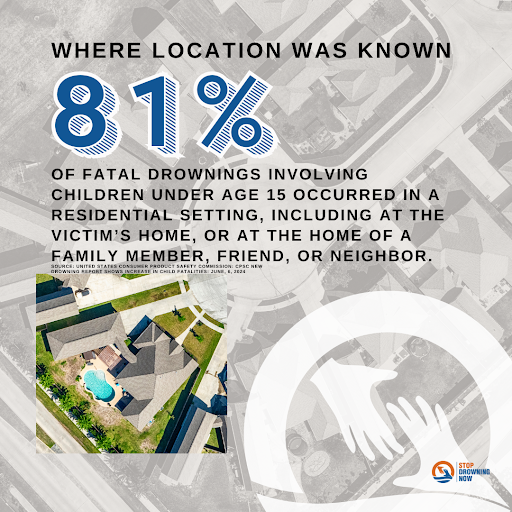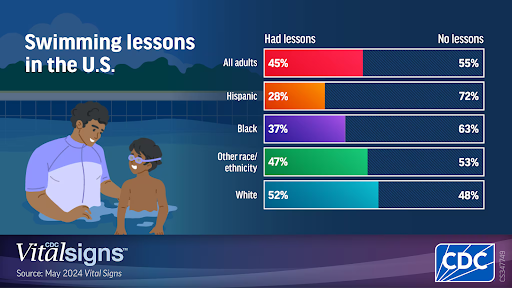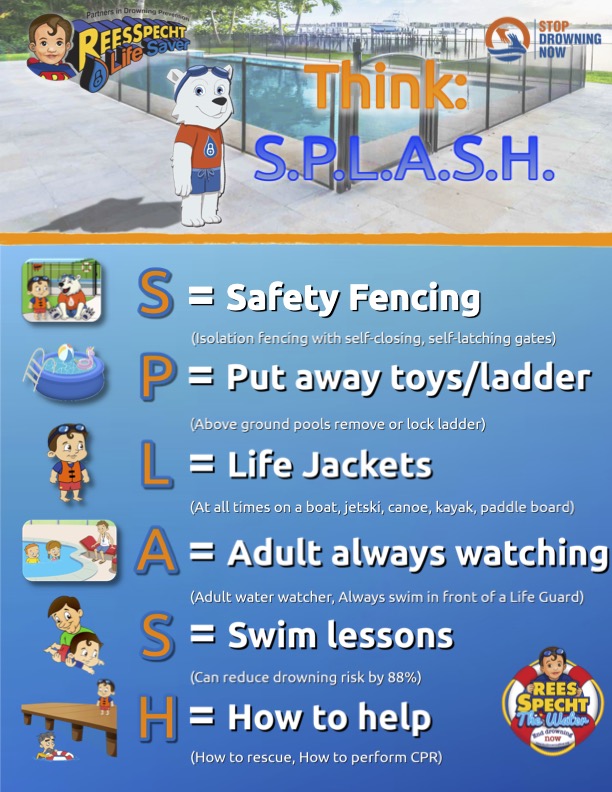Drowning remains the leading cause of death among children ages 1 to 4 years old, with a disproportionately higher risk for swimming-aged children in Black communities.
Consumer Product Safety Commission’s (CPSC) latest data show the following for children in the U.S. younger than 15 years of age:
- Between 2019 and 2021, there was an average of 358 pool- or spa-related fatal drownings reported per year, and 75% of those victims were younger than 5 years of age.
- The number of fatal child drownings in 2021 was 380, a 12 percent increase from the 339 fatal drownings reported in the previous year.
- Between 2021 and 2023, there was an average of 6,500 estimated pool- or spa-related, hospital emergency department (ED)-treated, nonfatal drowning injuries each year.
Additionally, the report highlighted specific drowning hazards for children under 5 years of age:
- In 2023, 77 percent of all estimated pool- or spa-related, ED-treated, nonfatal drowning injuries involved children younger than 5 years of age.
- Between 2019 and 2021, there was an average of 269 pool- or spa-related fatal drownings for children under 5, roughly 75 percent of the total average number of fatal drownings for all children under 15.
Where location was known, 81 percent of fatal drownings involving children under age 15 occurred in a residential setting, including at the victim’s home, or at the home of a family member, friend, or neighbor.
The report also highlights the continuing trend of racial disparities in drowning fatalities. Out of the 71 percent of drowning fatalities involving children under age 15 whose race was specified, African American children made up 23 percent of all drownings, higher than 15 percent of the population for that age.

Drowning deaths are on the rise in the United States, following decades of decline, according to a new CDC Vital Signs study released today. Over 4,500 people died due to drowning each year from 2020–2022, 500 more per year compared to 2019.
CDC experts looked at drowning deaths, self-reported swimming skills, participation in swimming lessons, and exposure to recreational water for this latest Vital Signs report. The report explores how increased access to basic swimming and water safety skills training can save lives.

Groups already at higher risk saw the greatest increases in drowning deaths: children 1-4 years old and adults 65 years and older of all races and ethnicities, as well as Black people of all ages.
Drowning is the number one cause of death for children 1-4 years old in the United States. Today’s study shows that drowning rates were highest among this age group. By race and ethnicity, the highest drowning rates were among non-Hispanic American Indian or Alaska Native and non-Hispanic Black persons.
Making swimming lessons accessible can save lives. Almost 40 million adults (15.4%) in the United States do not know how to swim and over half (54.7%) have never taken a swimming lesson. More than 1 in 3 (36.8%) Black adults reported they do not know how to swim compared to 15% of all adults. Additionally, 2 in 3 Black adults (63%) and 3 in 4 Hispanic adults (72%) reported never taking a swimming lesson. Research suggests the difference in self-reported swimming ability may be linked to differences in access to swimming lessons or other historical and social factors. For example, swimming lessons may be too expensive or not available in some communities, some may fear water, or others may feel uncomfortable wearing traditional swimwear.
The CDC Vital Signs findings can guide solutions at the local, state, and federal level to protect communities and prevent drowning tragedies. CDC continues to share information to increase understanding of the importance of accessible basic swimming and water safety skills training, a proven and effective way to prevent drowning. CDC also actively works with organizations across the country and around the world to conduct research to better understand barriers to basic swimming and water safety skills training and develop resources that protect everyone’s health and safety and decrease drowning risk. Policy makers, public health professionals, and communities can focus on building inclusive programs that best meet the needs of their communities.
Everyone can prevent drowning by:
- Learning basic swimming and water safety skills. Children who have had swimming lessons still need close and constant supervision when in or around water.
- Building fences that fully enclose and separate the pool from the house. Fences should be at least four feet high with self-closing and self-latching gates.
- Wearing a life jacket while boating for people of all ages and swimming abilities.
- Not drinking alcohol before or during swimming, boating, or other water activities. Alcohol impairs judgment, balance, and coordination. Do not drink alcohol while supervising children.
- Learning CPR skills. Performing CPR could save someone’s life in the time it takes for paramedics to arrive.
A study conducted by Griffith University found that children who participate in early swimming lessons, before the age of five, tend to be significantly ahead of their peers in various developmental areas, including cognitive skills, physical development, and social-emotional abilities, potentially achieving milestones up to 15 months earlier than non-swimming children; this includes improved abilities in areas like following instructions, problem solving, mathematics, language, and motor skills.

For more information about this study, follow this link.
